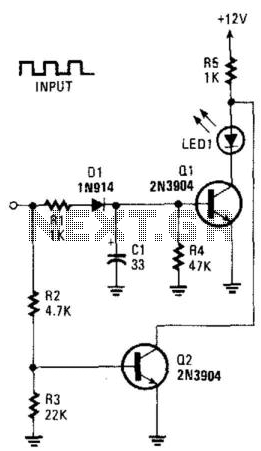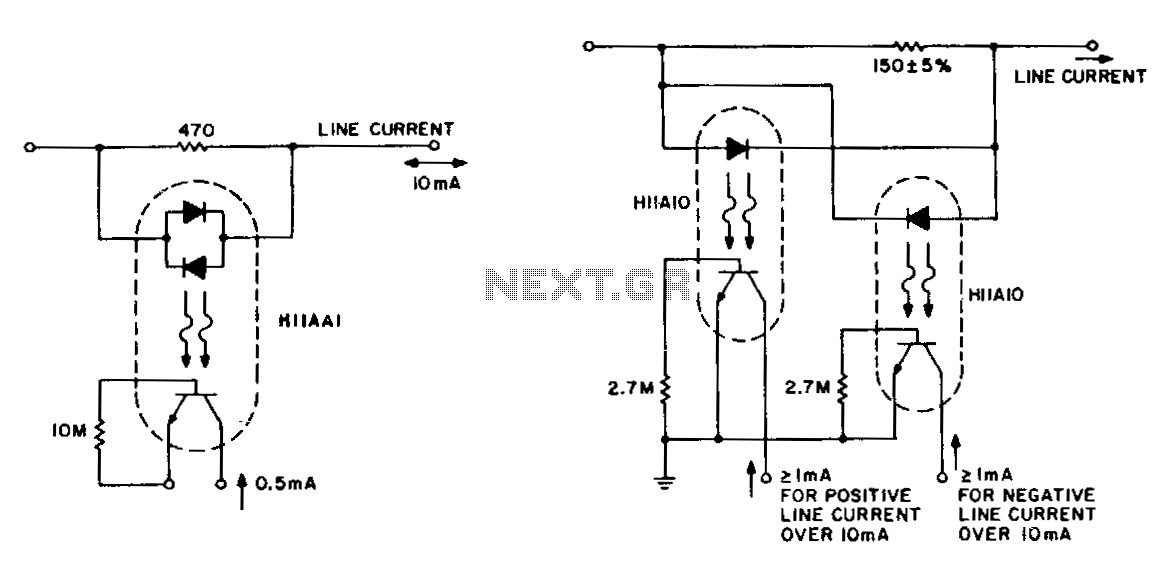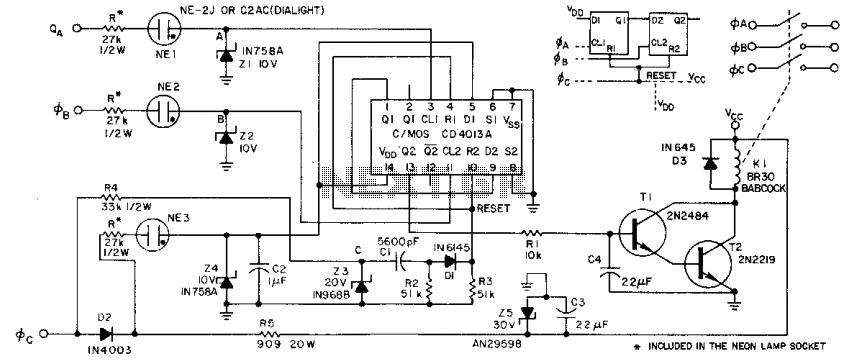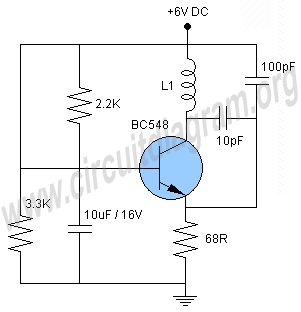
ultrasonic motion detector
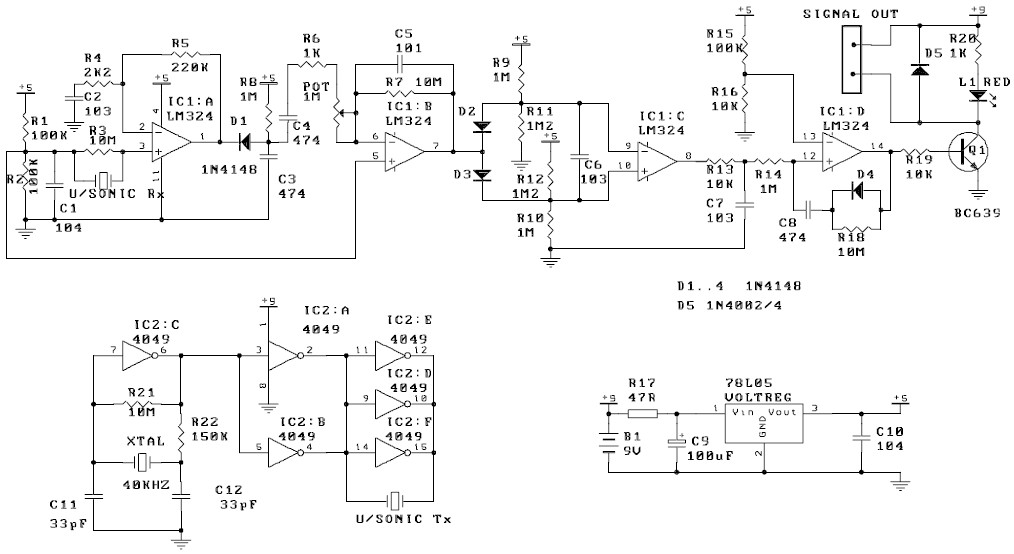
The circuit described exhibits high sensitivity to movement, capable of detecting even slight air movements such as hot air rising or wind blowing when the trimpot is adjusted to a sensitive position. The transmitter emits a continuous ultrasonic tone at 40 kHz. This circuit regulates the initial frequency and modulates the response of the envelope follower to the input signal. The envelope follower/filter combination translates the dynamic characteristics of the input into modulated timbral changes, functioning similarly to an automatic wah-wah pedal. Independent knobs for Initial Frequency and Sensitivity allow for user adjustments. This circuit is also utilized to determine the active status of a phone line.
Components List:
- R1, R2, R3 = 22 MΩ
- R4 = 2.2 MΩ
- C1 = 0.47 µF/250V Mylar capacitor
- D1 = 1N914, NTE519, or other small-signal diodes
- Q1 = 2N3904, NTE123AP
- Q2 = 2N3906, NTE159
- Q3 = IRF510, NTE2382, MOSFET
The circuit can also be classified as a tone detector circuit, which is often referred to as a sound-activated switch circuit. These circuits typically incorporate microcontrollers for switching functions, designed for applications such as robotic startup activation. However, a switching module can also be constructed using a relay.
Additionally, a simple metal detector circuit can be created using a CS209A integrated circuit (IC). This circuit has demonstrated impressive results while consuming minimal current from a 9-volt battery. Although it performed well in controlled environments, its effectiveness may diminish in outdoor settings for conventional metal detection tasks. Nonetheless, it remains an excellent option for sensing applications.
The overall design of these circuits emphasizes versatility and adaptability, making them suitable for various electronic projects, including movement detection, tone detection, and metal sensing. Each component plays a critical role in ensuring the functionality and reliability of the circuit, allowing for precise control and response to environmental stimuli.The circuit claimed has a high movement sensitivity. Even air moving (hot air rising, wind blowing) will trigger it when the trimpot is set near the most sensitive position. The transmitter sends out a steady ultrasonic tone at 40kHz. At this frequency the wavelength is. This ci rcuit will controls the initial frequency and controls how much the envelope follower responds to the input signal. An envelope follower/filter combination translates the typical dynamic properties of your axe into modulated timbral changes too, you could feel of it as an automatic wah-wah pedal.
Independent Initial Frequency and Sensitivity knobs provide you with. This circuit is used to detect whether your phone line is active or not. Components List: R1, R2, R3 = 22M Ohms R4 = 2. 2M Ohms C1 = 0. 47uF/250V Mylar caps D1 = 1N914, NTE519, or other small signal diode Q1 = 2N3904, NTE123AP Q2 = 2N3906, NTE159 Q3 = IRF510, NTE2382, MosFet This kind of circuit. The following circuit diagrams are tone detector circuit diagrams which also known as sound activated switch circuit.
Actually, these circuits use microntroller for switching because the circuits were designed for robot start up activation. But you can build switching module using relay. Tone Detector diagram 1 Tone Detector diagram 2 Tone Detector diagram 3 Tone. This is a very simple and easy build metal detector circuit, built based on a CS209A IC. The circuit will give surprising results and draws extremely small current from a 9 volt battery. It worked great on the Bench, But not so good outside for common metal detecting. But Definately a great circuit for sensing. 🔗 External reference
Components List:
- R1, R2, R3 = 22 MΩ
- R4 = 2.2 MΩ
- C1 = 0.47 µF/250V Mylar capacitor
- D1 = 1N914, NTE519, or other small-signal diodes
- Q1 = 2N3904, NTE123AP
- Q2 = 2N3906, NTE159
- Q3 = IRF510, NTE2382, MOSFET
The circuit can also be classified as a tone detector circuit, which is often referred to as a sound-activated switch circuit. These circuits typically incorporate microcontrollers for switching functions, designed for applications such as robotic startup activation. However, a switching module can also be constructed using a relay.
Additionally, a simple metal detector circuit can be created using a CS209A integrated circuit (IC). This circuit has demonstrated impressive results while consuming minimal current from a 9-volt battery. Although it performed well in controlled environments, its effectiveness may diminish in outdoor settings for conventional metal detection tasks. Nonetheless, it remains an excellent option for sensing applications.
The overall design of these circuits emphasizes versatility and adaptability, making them suitable for various electronic projects, including movement detection, tone detection, and metal sensing. Each component plays a critical role in ensuring the functionality and reliability of the circuit, allowing for precise control and response to environmental stimuli.The circuit claimed has a high movement sensitivity. Even air moving (hot air rising, wind blowing) will trigger it when the trimpot is set near the most sensitive position. The transmitter sends out a steady ultrasonic tone at 40kHz. At this frequency the wavelength is. This ci rcuit will controls the initial frequency and controls how much the envelope follower responds to the input signal. An envelope follower/filter combination translates the typical dynamic properties of your axe into modulated timbral changes too, you could feel of it as an automatic wah-wah pedal.
Independent Initial Frequency and Sensitivity knobs provide you with. This circuit is used to detect whether your phone line is active or not. Components List: R1, R2, R3 = 22M Ohms R4 = 2. 2M Ohms C1 = 0. 47uF/250V Mylar caps D1 = 1N914, NTE519, or other small signal diode Q1 = 2N3904, NTE123AP Q2 = 2N3906, NTE159 Q3 = IRF510, NTE2382, MosFet This kind of circuit. The following circuit diagrams are tone detector circuit diagrams which also known as sound activated switch circuit.
Actually, these circuits use microntroller for switching because the circuits were designed for robot start up activation. But you can build switching module using relay. Tone Detector diagram 1 Tone Detector diagram 2 Tone Detector diagram 3 Tone. This is a very simple and easy build metal detector circuit, built based on a CS209A IC. The circuit will give surprising results and draws extremely small current from a 9 volt battery. It worked great on the Bench, But not so good outside for common metal detecting. But Definately a great circuit for sensing. 🔗 External reference
